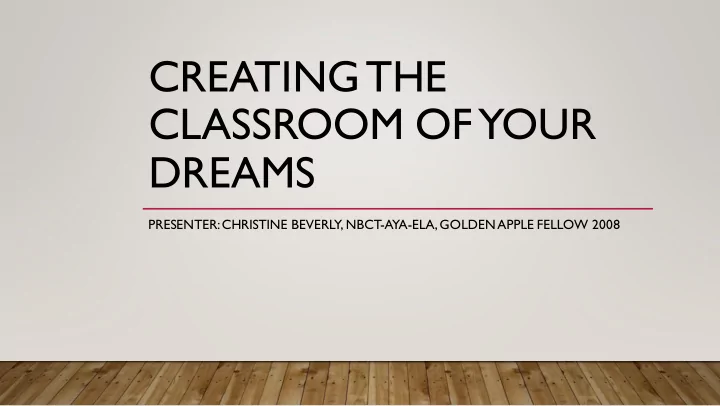

CREATING THE CLASSROOM OF YOUR DREAMS PRESENTER: CHRISTINE BEVERLY, NBCT-AYA-ELA, GOLDEN APPLE FELLOW 2008
PRECEPT 1: CLASSROOM MANAGEMENT AND BEHAVIOR MANAGEMENT AREN'T THE SAME.
CLASSROOM VS. BEHAVIOR MANAGEMENT • Classroom Management • Behavior Management 1. Proactive 1. Generally reactive 2. Requires set up prior to class. 2. Requires spur of the moment problem solving, but can be planned for if 3. Entirely within the teacher's control problem behavior is anticipated. 4. Affects all students 3. T eacher & student negotiate together. 5. Creates shared responsibility in the 4. Affects most directly the single student classroom. whose behavior is at issue. 5. Responsibility is carried by the teacher.
PRECEPT 2: CLASSROOM ENVIRONMENT REFLECTS WHAT THE TEACHER VALUES.
CLASSROOM ENVIRONMENT IS AT THE CENTER OF OUR WORK Envision your ideal class-- 1. What are the students doing? 2. What is the teacher doing? 3. What does the relationship of student to teacher look like? 4. How might the classroom environment reflect those ideals?
TEACHERS' VALUES ARE REFLECTED IN CLASS RULES What do these classroom rules tell you about what the teacher values in the classroom?
TEACHERS' VALUES ARE REFLECTED IN ROOM SET UP • What do you see in this classroom that reflects what is important to the teacher?
THINK ABOUT YOUR CLASSROOM... What message does the environment convey to the students about what you value?
PRECEPT 3: CLASSROOM MANAGEMENT INVOLVES RULES AND PROCEDURES. And they aren't the same thing...
RULES AND PROCEDURES ARE THE CORE OF YOUR DREAM CLASSROOM RULES PROCEDURES 1. Only a few! (5 or fewer...) 1. As many as you need to run the classroom smoothly. 2. Clearly Stated 2. Practiced. 3. Positively worded 3. Define how the room will function. 4. Define acceptable/desired behaviors. 4. Create a culture of cooperation and 5. Applicable to all situations and all responsibility in the classroom. students.
POSTING RULES ISN'T ENOUGH! • Must be DEFINED. Rule: Respect the teacher and other students. What does this look like? • Must have CONSEQUENCES for violations — should be posted! If you don't, what will be the first consequence? The second? The third? A referral to the office should be the LAST consequence...not the first. • Must be ENFORCED.
PROCEDURES ARE KEY TO AN EFFICIENT LEARNING ENVIRONMENT Some ideas for procedures to teach: 1. Entering the classroom 2. Getting materials 3. Turning in work 4. Asking questions 5. Getting make up work for absences 6. Dealing with electronics...etc. Note: Procedures must be taught...and re-taught.
BEGINNING THE CLASS Bellwork or Bellringers are a great way to start a class. 1. Post conspicuously. 2. Post regularly. 3. Keep directions simple. Allows teacher time to get attendance taken while students are working.
KEEPING TRACK OF WORK FOR ABSENT STUDENTS Class Secretary is ONE method 1. Teaches student responsibility (both the secretary and the returning student.) 2. Eases burden on the instructor. 3. Fits "record keeping" descriptor on Level 4 of Teacher Eval.
HEADINGS FOR PAPERS Be consistent. Easier if a department or whole school can agree to one format. If not, make sure it's posted!
COMING INTO CLASS LATE • A tardy check in station is ONE solution 1. Record keeping! 2. Student responsibility • Y our school may have other requirements...
STORING STUDENT WORK Binders? Writing Folders? Notebooks? Student Centered? T eacher Centered?
TURNING IN WORK ( & PICKING UP HANDOUTS) • Baskets? Slots? • Will students collect? (Keeps them in desks.) • Will students turn in? (Allows movement.) • Where do they find recent copies of handouts?
GETTING INTO GROUPS • T eacher will set? Students will choose? • What kinds of procedures can be used to create groups quickly? • Popsicle sticks? • Playing cards? • Numbering off?
A WORD ABOUT NORMS • Definition of norm : Informal guideline about what is considered normal (what is correct or incorrect) social behavior in a particular group or social unit. • + Can be powerful in setting behavior expectations. • - Take instructional time to develop.
NOW, IDEA AND PROBLEM SWAP! 1. What procedures have worked for you? 2. What are problem areas that you need ideas for? Note: Procedures must be taught...and re-taught.
Recommend
More recommend